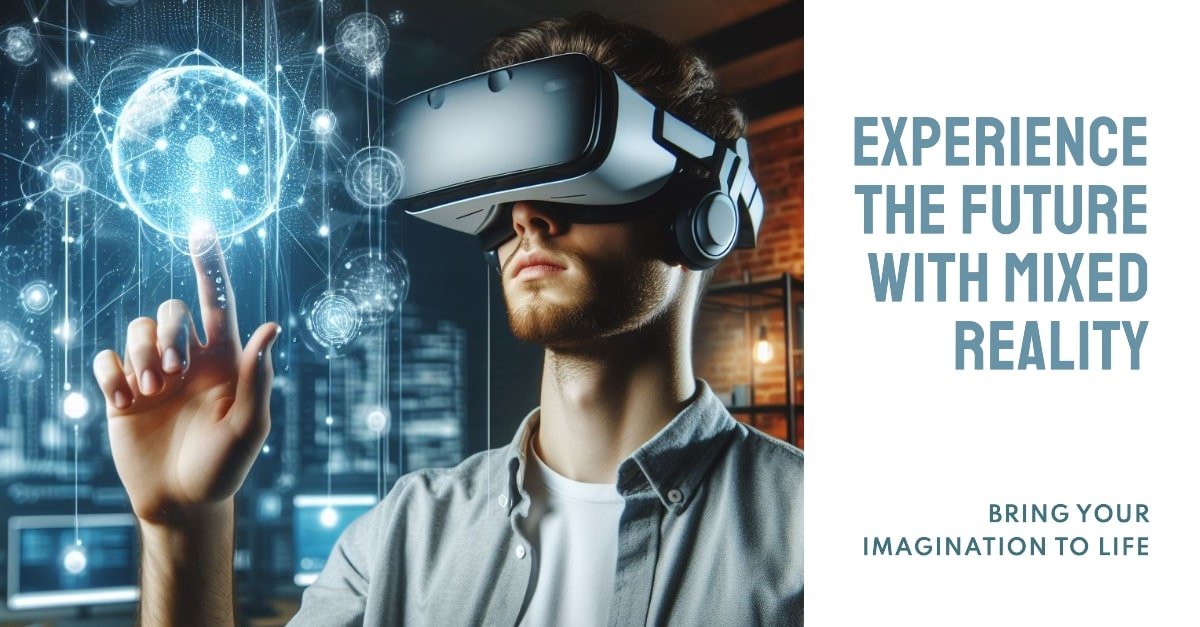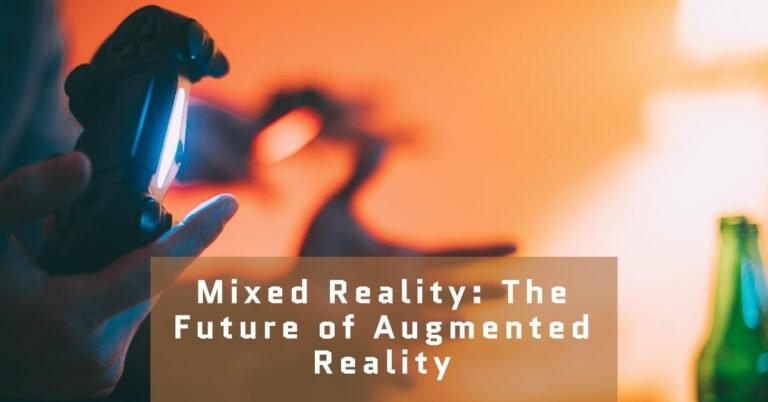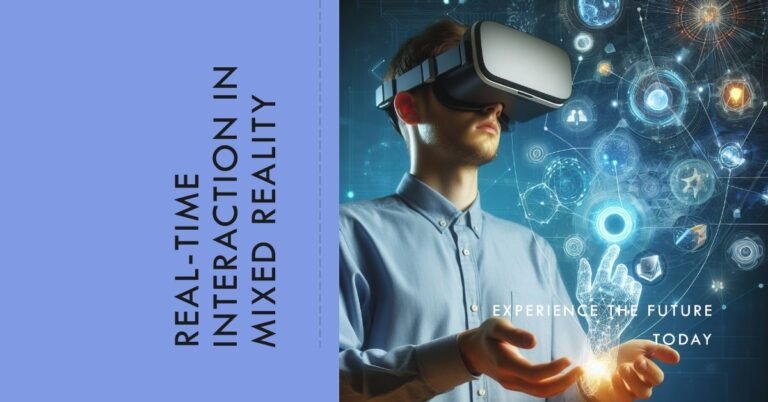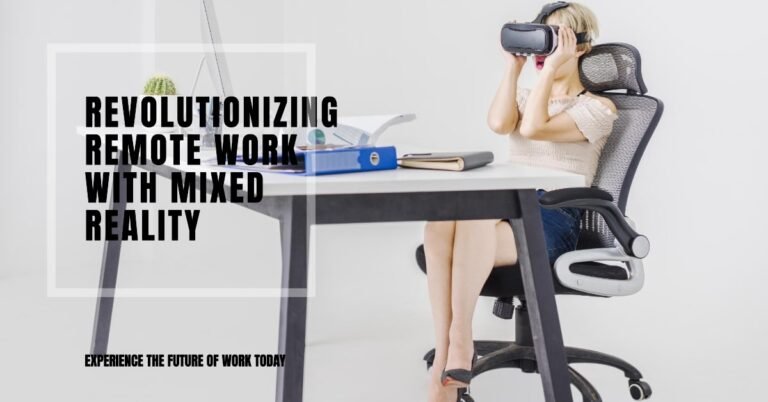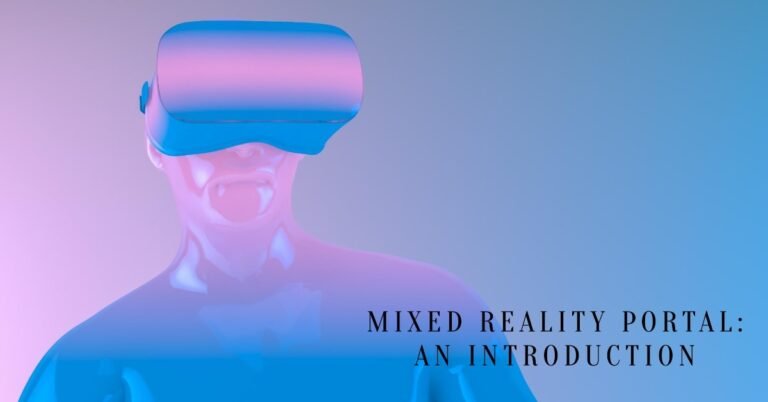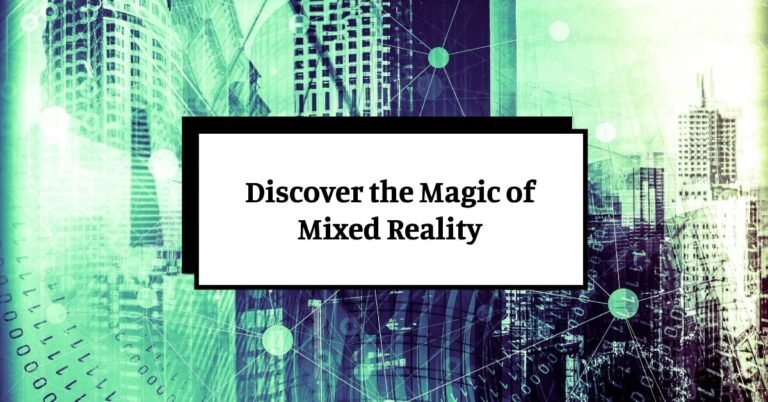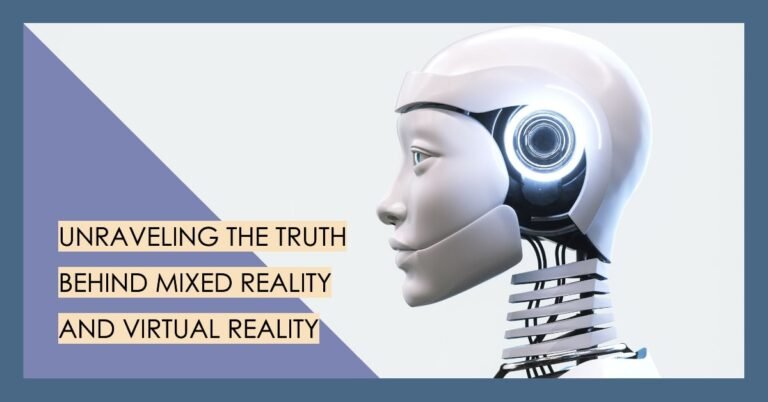Can You Actually TOUCH Objects in Mixed Reality? Mind-Blowing Tech Explained!
Welcome to ARVRRealm.com, where the future is just a touch away! Have you ever wondered if the digital wonders you see through your screen could be as real as the phone in your hand? Well, hold onto your seats because we’re about to unravel the mind-blowing technology of mixed reality (MR) that’s making this possible!
Imagine reaching out and feeling the smooth texture of a 3D model in your hand, or the rough surface of a virtual brick wall. While we can’t physically touch objects in traditional virtual reality (VR), mixed reality (MR) offers a glimpse into a future where touch and manipulation become an integral part of the experience. But can you actually feel things in mixed reality today? Let’s delve into the fascinating world of MR and explore the cutting-edge tech that’s pushing the boundaries of human-computer interaction.
What is Mixed Reality?
Mixed reality (MR) is a revolutionary technology that seamlessly blends the physical world with the virtual world. Unlike virtual reality (VR), which completely immerses you in a computer-generated environment, MR overlays digital elements onto the real world you see in front of you. This creates a truly interactive experience where you can see and interact with both physical and virtual objects simultaneously.
Think of it like this: imagine holding a real wrench in your hand while seeing a virtual instruction manual projected onto the engine you’re repairing. Or, picture yourself walking through your living room, but with virtual furniture appearing in place to help you plan your dream renovation. The possibilities are truly endless!
The Evolution of Interactive Tech: From VR to MR
To understand MR fully, it’s helpful to consider its place within the broader spectrum of immersive technologies. Here’s a breakdown of the key players:
- Virtual Reality (VR): VR transports you entirely into a computer-generated world. You wear a headset that blocks out your physical surroundings and replaces them with a virtual environment. While VR can be incredibly realistic visually and even incorporate auditory and motion-based feedback, there’s currently no way to physically interact with virtual objects using touch.
- Augmented Reality (AR): AR overlays digital information onto the real world through a smartphone, tablet, or specialized headset. A popular example is the game Pokémon Go, where virtual creatures appear on your phone screen within your real-world environment. While AR allows for some interaction with virtual objects (like tapping on a virtual button), there’s no physical sensation of touch.
- Mixed Reality (MR): MR bridges the gap between VR and AR, creating a hybrid environment where the physical and virtual worlds coexist and interact. MR headsets allow you to see both the real world and virtual objects superimposed on it. This opens the door for exciting possibilities, including the potential for touch interaction, which we’ll explore in detail later.
Understanding Mixed Reality
MR technology relies on a combination of sophisticated hardware and software components to function. Here’s a breakdown of the key elements:
- Headsets: MR headsets are the primary interface between you and the mixed reality experience. They typically feature high-resolution displays to project both the real world (captured by built-in cameras) and the virtual world seamlessly. Some advanced headsets also incorporate eye-tracking technology for more intuitive interaction.
- Sensors: MR headsets are packed with various sensors, including depth sensors, accelerometers, and gyroscopes. These sensors track your head movements, hand positions, and even eye movements, allowing the virtual elements to adapt and respond realistically.
- Software: The software behind MR experiences is crucial. It’s responsible for rendering the virtual world, tracking real-world elements, and ensuring smooth interaction between the two. Developers use specialized software development kits (SDKs) to create MR applications that take advantage of the unique capabilities of this technology.
How MR Differs from VR and AR
While VR, AR, and MR all fall under the umbrella of immersive technologies, they offer distinct experiences. Here’s a table summarizing the key differences:
| Feature | Virtual Reality (VR) | Augmented Reality (AR) | Mixed Reality (MR) |
| Environment | Fully computer-generated | Overlays digital information on the real world | Blends physical and virtual worlds |
| Hardware | Headsets | Smartphones, tablets, or specialized headsets | Headsets |
| Interaction | Primarily visual and auditory, limited physical interaction | Primarily visual, some touch interaction possible on devices | Combines visual, auditory, and potentially haptic interaction |
| Applications | Gaming, entertainment, simulation training | Education, information visualization, product visualization | Education, training, design, collaboration |
Touching the Untouchable: Can You Feel Objects in Mixed Reality?
This brings us to the million-dollar question: can you actually feel things in mixed reality today? The answer is not quite yet, but we’re getting closer! Current MR technology primarily focuses on visual interaction. However, the realm of haptics – the science of touch technology – is rapidly evolving. Researchers are developing advanced haptic gloves and controllers that can simulate the sensation of touch when interacting with virtual objects in MR. Imagine reaching out and feeling the smooth surface of a 3D architectural model or the rough, calloused hand of a virtual historical figure. These advancements promise to revolutionize the way we interact with the virtual world in MR.
The Science of Haptic Feedback
Haptic technology works by creating a variety of sensations on the user’s hands or body. Here are some of the promising approaches being explored for MR applications:
- Ultrasonic Haptics: This technology uses ultrasonic waves to create pressure points on your hand, simulating the feeling of touching virtual objects. Imagine feeling the ridges of a virtual mountain range or the coolness of a virtual glass of water. Tiny ultrasonic transducers embedded in gloves or controllers emit inaudible sound waves that create focused areas of pressure on your skin, mimicking the sensation of texture and shape.
- Electromagnetic Haptics: This approach utilizes electromagnetic fields to generate a pulling or pushing sensation on your hand. Imagine feeling the weight of a virtual object as you pick it up or the resistance of a virtual door as you try to open it. Electromagnets within haptic devices create targeted forces that pull or push on your hand, replicating the sensation of interacting with physical objects.
- Exoskeleton Gloves: These gloves use motors and sensors to track your hand movements and provide physical feedback. Imagine feeling the resistance of a virtual button as you press down on it in the real world. Exoskeleton gloves are essentially robotic wearable devices that fit onto your hands. They incorporate tiny motors and sensors to track your hand movements and apply counter-forces, simulating the feeling of weight, resistance, and even texture of virtual objects.

How does haptic feedback work in mixed reality?
Haptic feedback in mixed reality (MR) is still under development, but it holds immense potential for creating a more realistic and interactive experience. Here’s a breakdown of how it works and the different approaches being explored:
The Goal: Mimicking Touch in the Virtual World
Traditional MR experiences primarily rely on visual and auditory cues. Haptic feedback aims to add another layer of immersion by simulating the sensation of touch when interacting with virtual objects. This can involve replicating feelings like texture, weight, resistance, and temperature.
Different Approaches to Haptic Feedback in MR:
- Ultrasonic Haptics: This technology uses ultrasonic waves to create focused points of pressure on your hand. Tiny transducers in gloves or controllers emit inaudible sound waves that manipulate your skin, mimicking the feeling of touching a virtual object’s shape and texture. Imagine feeling the ridges of a virtual mountain or the coolness of a virtual glass of water.
- Electromagnetic Haptics: This approach utilizes electromagnetic fields to generate pulling or pushing forces on your hand. Electromagnets within haptic devices create targeted forces that pull or push on your hand, simulating the sensation of weight or resistance. Imagine feeling the weight of a virtual object as you pick it up or the resistance of a virtual door as you try to open it.
- Exoskeleton Gloves: These wearable devices use motors and sensors to track your hand movements and provide physical feedback. Tiny motors within the gloves apply counter-forces in response to your movements, replicating the sensation of interacting with a virtual object that has weight, resistance, and even texture. Imagine feeling the resistance of a virtual button as you press down on it.
Challenges and Considerations:
- Accuracy and Realism: Replicating the complex sensations of touch remains a challenge. Researchers are working on creating more nuanced haptic experiences that can accurately simulate different textures, weights, and forces.
- Safety and Comfort: Haptic feedback needs to be carefully designed to avoid excessive force or discomfort for users. Prolonged exposure to strong vibrations or forces could lead to fatigue or even injuries.
The Future of Haptic Feedback in MR:
As haptic technology continues to evolve, we can expect more sophisticated and realistic touch experiences in MR. Here are some exciting possibilities:
- Enhanced Training and Education: Imagine surgeons feeling the texture of virtual organs during simulations or students manipulating delicate virtual objects in science experiments.
- Revolutionized Design and Manufacturing: Architects and engineers could feel the weight and texture of virtual materials as they design buildings or products in an MR environment.
- Hyper-realistic Gaming Experiences: Feeling the recoil of a virtual weapon or the resistance of a virtual object you’re manipulating in a game could take immersion to a whole new level.
Applications of Mixed Reality
The potential applications of mixed reality are vast and extend far beyond gaming and entertainment. Here are some exciting ways MR is transforming various industries:
Education and Training:
- Interactive Learning: Imagine students dissecting a virtual frog in biology class or exploring a 3D model of the solar system in astronomy. MR can bring complex concepts to life, making learning more engaging and interactive.
- Skills Development: MR can be used to create realistic training simulations for surgeons, firefighters, pilots, and other professionals. Trainees can practice procedures and techniques in a safe, controlled environment before applying them in the real world.
Healthcare Innovations:
- Remote Surgery: Surgeons can use MR to visualize a patient’s anatomy in 3D during surgery, allowing for greater precision and minimally invasive procedures.
- Physical Therapy: MR can be used to create interactive rehabilitation exercises that guide patients through their recovery process in a more engaging way.
Retail and E-Commerce:
- Virtual Try-On: Imagine trying on clothes or makeup virtually before you buy them. MR can revolutionize the online shopping experience by allowing customers to see how products would look on them without leaving their homes.
- Product Visualization: Customers can use MR apps to see how furniture or appliances would look in their homes before they purchase them. This can help with making informed buying decisions.
Entertainment and Gaming:
- Immersive Gaming Experiences: MR can take gaming to a whole new level. Imagine feeling the recoil of a virtual weapon or manipulating virtual objects in a game with your hands. The possibilities for creating truly immersive gaming experiences are endless.
- Interactive Entertainment: MR can be used to create interactive museum exhibits, theme park attractions, and even live performances that blend the physical and virtual worlds.
Building the MR Experience
Developing compelling MR experiences requires careful consideration of various factors. Here are some key aspects to keep in mind:
Designing for MR:
- Focus on User Interaction: Unlike traditional interfaces like keyboards and mice, MR experiences rely on natural hand movements and gestures for interaction. Designing intuitive and user-friendly interaction mechanics is crucial for creating a smooth and enjoyable experience.
- Spatial Awareness: MR experiences take place in real-world environments. Designers need to consider how virtual elements will interact with the physical space to ensure a seamless and safe experience for users.
- Content Creation: Developing high-quality 3D models and virtual environments is essential for creating immersive and engaging MR experiences.
Challenges and Considerations
While the future of MR is bright, there are still some challenges to overcome:
- Cost and Accessibility: Current MR hardware, particularly high-end haptic gloves and controllers, can be expensive. Making MR technology more affordable and accessible to the masses will be crucial for widespread adoption.
- Accuracy and Realism: Haptic technology is still evolving, and replicating the complex sensations of touch remains a challenge. Researchers are working on creating more nuanced haptic experiences that can truly fool our senses.
- Safety and User Comfort: Haptic feedback needs to be carefully designed to avoid excessive force or discomfort for users. Prolonged exposure to strong vibrations or forces could lead to fatigue or even injuries.
- Privacy and Security Concerns: As MR experiences become more sophisticated, they will likely collect and store user data related to movements, interactions, and even eye tracking. Ensuring user privacy and data security will be paramount as MR technology continues to develop.
The Future of Mixed Reality
Despite these challenges, the future of mixed reality is brimming with possibilities. Here are some exciting trends to watch out for:
- Advancements in Haptics: As haptic technology continues to evolve, we can expect more realistic and nuanced touch sensations in MR experiences. Imagine feeling the grain of virtual wood or the weight of a virtual object in your hand. These advancements will blur the lines between the physical and virtual worlds even further.
- Integration with Artificial Intelligence (AI): AI will play a crucial role in enhancing MR experiences. AI can be used to personalize content, understand user intent, and create more natural and intuitive interactions within the virtual world.
- The Rise of Cloud-Based MR: Cloud computing can be leveraged to deliver powerful processing and rendering capabilities for MR experiences. This could eliminate the need for bulky headsets and allow users to access MR content through lightweight glasses or mobile devices.
- Focus on Collaboration and Social Interaction: MR has the potential to revolutionize the way we collaborate and socialize. Imagine attending virtual meetings where colleagues appear as life-sized holograms in your workspace, or working on design projects together in a shared virtual environment.
Role of AI in Enhancing MR
As mentioned earlier, AI will play a significant role in shaping the future of mixed reality. Here’s how:
- Personalized Learning: AI can personalize MR learning experiences by adapting content and difficulty levels to individual user needs.
- Intelligent Assistants: AI-powered virtual assistants can guide users through MR experiences, provide relevant information on demand, and anticipate their needs.
- Natural Language Processing (NLP): NLP can enable users to interact with MR environments using natural language commands, making the experience more intuitive and user-friendly.

FAQs: Common Questions About MR Answered
What is the difference between AR and MR?
AR overlays digital information onto the real world, while MR blends the physical and virtual worlds, allowing you to interact with both simultaneously.
Do I need a special headset to experience MR?
Yes, you currently need a specialized MR headset to experience mixed reality fully. However, advancements in smartphone technology may lead to more accessible MR experiences in the future.
What are some applications of MR in the workplace?
MR can be used for training, design collaboration, product visualization, and remote maintenance tasks in various industries.
Is MR safe for children?
While MR is generally safe, it’s essential to monitor children’s usage and ensure they take breaks to avoid eye strain or discomfort.
What are the ethical considerations of MR?
Privacy, data security, and the potential for addiction to virtual experiences are some ethical considerations that need to be addressed as MR technology evolves.
Conclusion: Summing Up the MR Experience
Mixed reality offers a glimpse into a future where the boundaries between the physical and virtual worlds are blurred. While we can’t quite feel objects in MR yet, the rapid advancements in haptic technology promise to change that soon. From revolutionizing education and training to transforming industries like healthcare and retail, the possibilities of MR are vast and exciting. As MR technology continues to mature, we can expect even more immersive and interactive experiences that will change the way we work, learn, and play.
Ready to explore the exciting world of AR/VR? Dive deeper into ARVRRealm.com for the latest news, reviews, and insights on this ever-evolving technology!
The Next Steps in Mixed Reality
The future of mixed reality is bright. Here are some ways you can stay informed and involved:
- Follow industry leaders and publications: Keep up with the latest developments in MR by following leading companies, research institutions, and technology publications.
- Explore MR experiences: If you have the opportunity, try out some MR applications or visit an MR experience center. This will give you a firsthand feel for the potential of this technology.
- Get involved in the conversation: Share your thoughts and ideas about MR on social media or online forums. As MR technology evolves, user feedback will be crucial for shaping its development.
The world of mixed reality is waiting to be explored. Are you ready to take the plunge?
